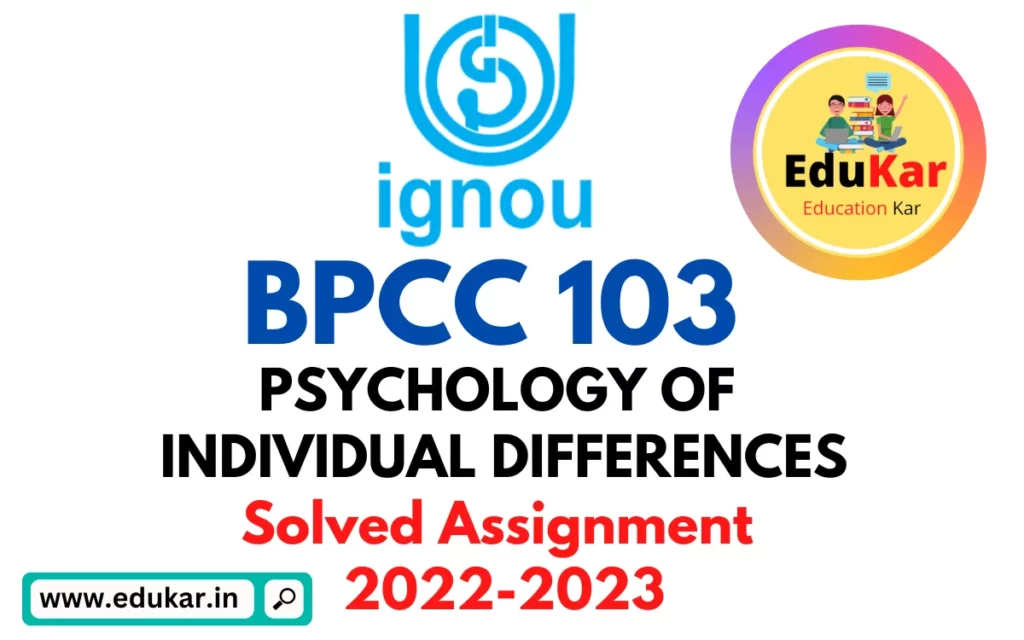Contents
- 1 Assignment One
- 2 Answer the following descriptive category questions in about 500 words each. Eachquestion carries 20 marks.
- 3 1. Discuss the nature, types and theories of motivation.
- 4 2. Elaborate upon the nature, types and models of memory.
- 5 3. Discuss the nature and scope of psychology.
- 6 Assignment Two
- 7 Answer the following short category questions in about 100 words each. Each question carries 5 marks.
- 8 4. Manifestation and Measurement of Emotions
- 9 5. Decision Making.
- 10 6. Laws of Organization: Gestalt Principles.
- 11 7. Monocular Cues.
- 12 8. Stages of Perception.
- 13 9. Psychology: As a Science.
- 14 10. Cognitive learning.
- 15 11. Language in Infants.

| Title | BPCC-101: IGNOU BAG Solved Assignment 2022-2023 |
| University | IGNOU |
| Degree | Bachelor Degree Programme |
| Course Code | BPCC-101 |
| Course Name | INTRODUCTION TO PSYCHOLOGY |
| Programme Name | Bachelor of Arts (General) |
| Programme Code | BAG |
| Total Marks | 100 |
| Year | 2022-2023 |
| Language | English |
| Assignment Code | ASST/TMA/2022-23 |
| Last Date for Submission of Assignment: | For June Examination: 31st April For December Examination: 30th September |
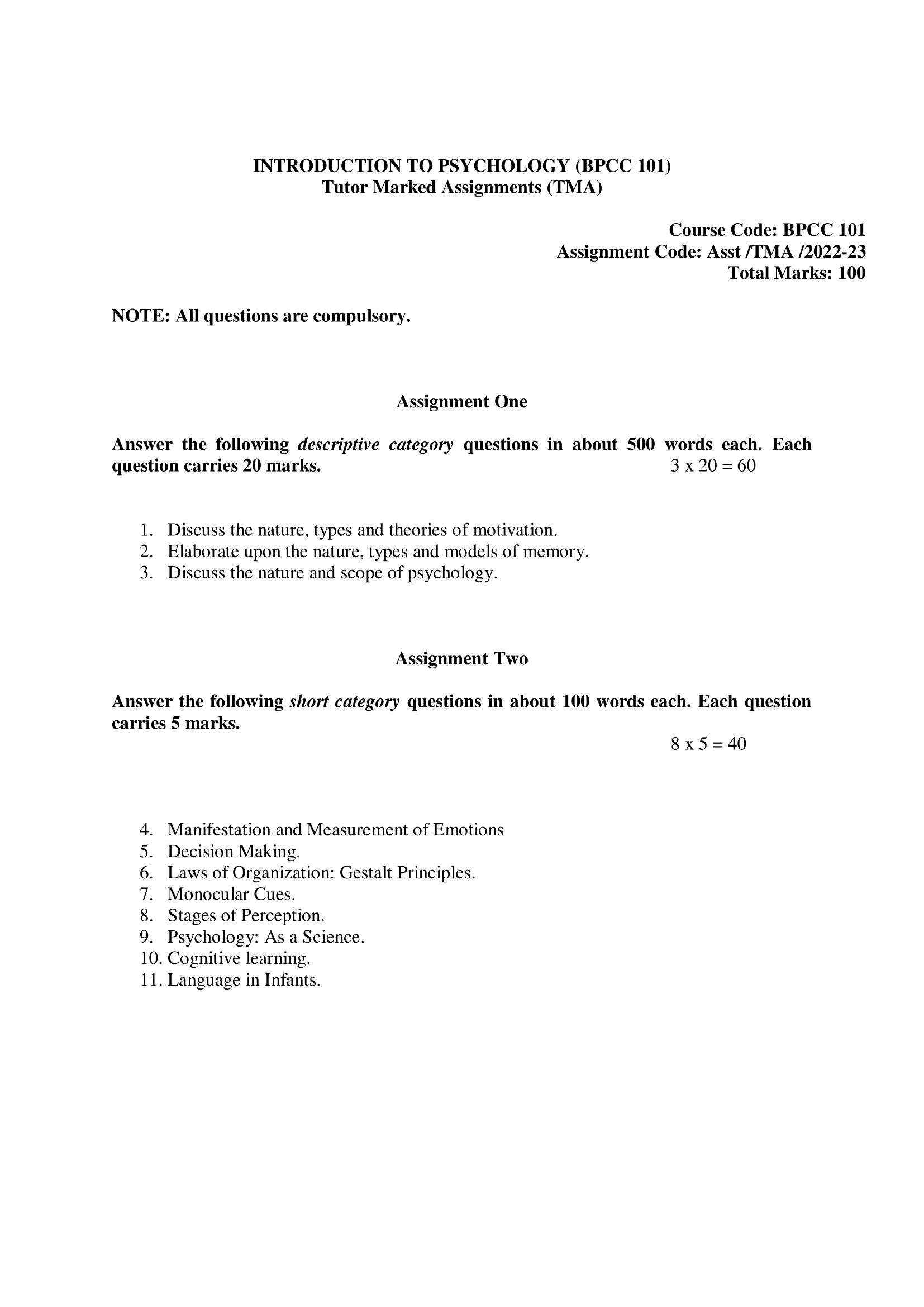
Assignment One
Answer the following descriptive category questions in about 500 words each. Each
question carries 20 marks.
1. Discuss the nature, types and theories of motivation.
Ans: Motivation is a complex construct that refers to the driving force that compels individuals to take action towards achieving their goals or satisfying their needs. It is an internal psychological process that initiates, guides, and maintains behavior. Understanding motivation is essential for both individuals and organizations to achieve their goals and improve performance. In this essay, we will discuss the nature, types, and theories of motivation.
Nature of Motivation: Motivation is an internal psychological process that originates from an individual’s thoughts, emotions, and desires. It is an individual’s need for satisfaction that compels them to take action towards achieving their goals. Motivation can be intrinsic, which refers to the internal drive that comes from an individual’s interests, passions, and values. On the other hand, motivation can be extrinsic, which refers to external factors that motivate individuals, such as rewards, recognition, and status.
Types of Motivation: There are two types of motivation: Intrinsic and extrinsic motivation. Intrinsic motivation is the internal drive that comes from an individual’s interests, passions, and values. This type of motivation is driven by the desire to perform an activity for its own sake, rather than for external rewards. Examples of intrinsic motivation include pursuing hobbies, learning new skills, and engaging in creative activities. Extrinsic motivation, on the other hand, is the external drive that comes from external factors such as rewards, recognition, and status. This type of motivation is driven by the desire to achieve external rewards and avoid negative consequences. Examples of extrinsic motivation include working to earn a salary, receiving recognition for a job well done, and avoiding punishment.
Theories of Motivation: There are several theories of motivation that attempt to explain why individuals behave the way they do. Here are some of the major theories of motivation:
- Maslow’s Hierarchy of Needs: Abraham Maslow proposed that individuals have a hierarchy of needs that must be met in order to achieve self-actualization. The hierarchy of needs includes physiological needs, safety needs, social needs, esteem needs, and self-actualization needs.
- Herzberg’s Two-Factor Theory: Frederick Herzberg proposed that individuals are motivated by two types of factors: hygiene factors and motivators. Hygiene factors refer to basic needs such as salary, working conditions, and job security, while motivators refer to factors such as recognition, achievement, and growth opportunities.
- Expectancy Theory: Victor Vroom proposed that motivation is determined by the perceived relationship between effort, performance, and outcomes. According to this theory, individuals will be motivated to perform a task if they believe that their efforts will result in high performance and desirable outcomes.
- Self-Determination Theory: Edward Deci and Richard Ryan proposed that individuals have three innate psychological needs: autonomy, competence, and relatedness. These needs must be satisfied for individuals to be motivated and engaged in their work.
- Goal-Setting Theory: Edwin Locke and Gary Latham proposed that setting specific and challenging goals can increase motivation and performance. This theory suggests that individuals will be more motivated to achieve specific goals than general goals.
2. Elaborate upon the nature, types and models of memory.
Ans: Memory is the ability of the brain to store, retain, and retrieve information. It plays a critical role in everyday life, allowing individuals to learn, adapt, and navigate their environment. Memory is a complex process that involves the encoding, storage, and retrieval of information. In this essay, we will discuss the nature, types, and models of memory.
Nature of Memory: Memory is a cognitive process that allows the brain to store and retrieve information. It involves three basic processes: encoding, storage, and retrieval. Encoding refers to the process of converting sensory information into a form that can be stored in the brain. Storage refers to the process of retaining information in the brain over time. Retrieval refers to the process of accessing stored information when it is needed.
Types of Memory: There are several types of memory, including sensory memory, short-term memory, and long-term memory.
- Sensory Memory: Sensory memory refers to the brief storage of sensory information in its original sensory form. It is the initial stage of memory processing and allows individuals to perceive the world around them. Sensory memory is divided into iconic memory, which stores visual information, and echoic memory, which stores auditory information.
- Short-Term Memory: Short-term memory, also known as working memory, is the temporary storage of information that is actively being processed. It has a limited capacity and can only hold a small amount of information for a brief period of time, typically around 20-30 seconds.
- Long-Term Memory: Long-term memory is the storage of information over an extended period of time. It has an unlimited capacity and can hold vast amounts of information. Long-term memory is further divided into two types: explicit memory and implicit memory. Explicit memory refers to conscious, intentional recollection of past experiences, such as facts, events, and personal experiences. Implicit memory, on the other hand, refers to unconscious memory that affects behavior and performance, such as skills, habits, and priming.
Models of Memory: There are several models of memory that attempt to explain how memory works. Here are some of the major models of memory:
- Atkinson-Shiffrin Model: The Atkinson-Shiffrin model proposes that memory is composed of three systems: sensory memory, short-term memory, and long-term memory. This model suggests that information is initially processed in sensory memory, moves to short-term memory, and then can be transferred to long-term memory if it is rehearsed or has significant meaning.
- Levels of Processing Model: The Levels of Processing model proposes that the depth of processing affects the strength of memory. This model suggests that information that is processed more deeply and meaningfully is more likely to be stored in long-term memory.
- Working Memory Model: The Working Memory model proposes that short-term memory is not a single system, but rather a multi-component system that includes a central executive, phonological loop, and visuospatial sketchpad. This model suggests that different types of information are processed and stored in separate components of short-term memory.
- Dual-Process Model: The Dual-Process model proposes that memory is composed of two systems: a declarative memory system and a non-declarative memory system. Declarative memory involves conscious, intentional recollection of past experiences, while non-declarative memory involves unconscious memory that affects behavior and performance.
3. Discuss the nature and scope of psychology.
Ans: Psychology is the scientific study of human behavior and mental processes. It is a field that encompasses a wide range of topics, including cognition, perception, emotion, personality, social behavior, and mental health. In this essay, we will discuss the nature and scope of psychology.
Nature of Psychology: Psychology is a scientific discipline that seeks to understand human behavior and mental processes through empirical research. It uses a systematic approach to gather data and draw conclusions about human behavior and mental processes. This data is often gathered through observation, experimentation, and surveys. The nature of psychology is also interdisciplinary, drawing from fields such as biology, sociology, anthropology, and philosophy.
Scope of Psychology: The scope of psychology is vast, covering a wide range of topics related to human behavior and mental processes. Here are some of the major areas of study in psychology:
- Developmental Psychology: Developmental psychology studies the changes that occur in human behavior and mental processes throughout the lifespan. It covers topics such as infancy, childhood, adolescence, adulthood, and aging.
- Social Psychology: Social psychology studies how individuals interact with each other and how social factors influence behavior and mental processes. It covers topics such as social perception, attitudes, group dynamics, and interpersonal relationships.
- Clinical Psychology: Clinical psychology is concerned with the assessment, diagnosis, and treatment of mental health disorders. It covers topics such as depression, anxiety, personality disorders, and schizophrenia.
- Cognitive Psychology: Cognitive psychology studies mental processes such as perception, attention, memory, language, and problem-solving. It seeks to understand how these processes work and how they influence behavior.
- Forensic Psychology: Forensic psychology applies psychological principles to legal issues. It covers topics such as eyewitness testimony, jury decision-making, and criminal behavior.
- Neuropsychology: Neuropsychology studies the relationship between the brain and behavior. It seeks to understand how brain function influences behavior and mental processes.
- Industrial-Organizational Psychology: Industrial-Organizational psychology applies psychological principles to the workplace. It covers topics such as employee selection, training, and motivation.
In addition to these areas of study, psychology also covers other topics such as health psychology, educational psychology, and environmental psychology. The scope of psychology is constantly expanding as new research is conducted and new topics emerge.
Assignment Two
Answer the following short category questions in about 100 words each. Each question carries 5 marks.
4. Manifestation and Measurement of Emotions
Ans: Emotions are complex psychological and physiological experiences that play a vital role in human behavior and communication. Manifestation and measurement of emotions are crucial for understanding emotional experiences and their impact on individuals and society.
Manifestation of Emotions: Emotions can be manifested in a variety of ways, including:
- Facial expressions: Facial expressions are the most visible and recognizable manifestation of emotions. Different emotions have specific facial expressions that are universally recognized, such as smiling for happiness or frowning for sadness.
- Body language: Body language refers to nonverbal cues, such as posture, gestures, and movements, that convey emotions. For example, a person may slouch and avoid eye contact when feeling sad or nervous.
- Verbal communication: Verbal communication, including tone of voice, volume, and choice of words, can also reflect emotions. A person’s tone of voice may be high-pitched and excited when feeling happy or low and flat when feeling depressed.
- Physiological changes: Emotions can also be manifested through physiological changes in the body, such as increased heart rate, sweating, or changes in breathing patterns.
Measurement of Emotions: Measuring emotions can be challenging because they are subjective experiences that vary from person to person. Some common methods used to measure emotions include:
- Self-report measures: Self-report measures involve asking individuals to rate their emotional experiences using questionnaires or surveys. This method is useful for identifying and comparing emotions across different groups of people.
- Physiological measures: Physiological measures involve measuring physiological changes in the body that are associated with emotional experiences, such as heart rate or skin conductance. This method is useful for understanding the physiological response to emotional stimuli.
- Behavioral measures: Behavioral measures involve observing and analyzing behavior that is associated with emotional experiences, such as facial expressions, vocal tone, or body language. This method is useful for understanding the social and communicative aspects of emotions.
- Brain imaging: Brain imaging techniques, such as functional magnetic resonance imaging (fMRI), can help identify the neural activity associated with emotional experiences. This method is useful for understanding the neural mechanisms of emotions.
5. Decision Making.
Ans: Decision making is the process of choosing between alternative options or courses of action based on available information and one’s preferences or goals. It is an essential skill for individuals, groups, and organizations to achieve their objectives effectively and efficiently.
The decision-making process involves several steps, including:
- Identifying the problem or opportunity: The first step is to recognize that a decision needs to be made. This may involve identifying a problem that needs to be solved or an opportunity that needs to be seized.
- Gathering information: Once the problem or opportunity has been identified, it is necessary to gather relevant information to make an informed decision. This may involve conducting research, consulting with experts, or analyzing data.
- Analyzing options: After gathering information, it is essential to analyze the available options to determine their potential advantages and disadvantages.
- Evaluating alternatives: The next step is to evaluate the alternatives based on various criteria such as feasibility, cost, benefits, risks, and alignment with goals.
- Choosing the best alternative: After evaluating the alternatives, the best option should be chosen based on the information available and the decision-makers’ preferences or goals.
- Implementing the decision: Once the decision has been made, it is necessary to implement it effectively, which may involve allocating resources, delegating tasks, and establishing a timeline.
- Evaluating the outcome: After implementation, it is crucial to evaluate the results to determine whether the decision was successful and achieved the desired outcome. If not, adjustments may need to be made.
Effective decision making requires critical thinking, problem-solving skills, and the ability to analyze information objectively. It is also essential to consider the potential consequences of each decision and to be prepared to adapt to changing circumstances.
6. Laws of Organization: Gestalt Principles.
Ans: The Gestalt principles are a set of laws of organization that describe how humans perceive and interpret visual information. These principles were first proposed by German psychologists in the early 20th century and are still widely used in fields such as graphic design, art, and visual perception research. The Gestalt principles are as follows:
- Law of Similarity: The law of similarity states that elements that are similar in shape, color, or texture tend to be perceived as a group or pattern. For example, rows of circles of different colors will be perceived as separate groups of circles based on their color.
- Law of Proximity: The law of proximity states that elements that are close together tend to be perceived as a group or pattern. For example, a row of dots that are close together will be perceived as a line rather than individual dots.
- Law of Closure: The law of closure states that humans tend to perceive incomplete shapes as complete shapes. For example, a circle with a small segment missing will be perceived as a complete circle.
- Law of Continuity: The law of continuity states that humans tend to perceive lines or patterns as continuing in a smooth, uninterrupted manner. For example, a broken line will be perceived as a continuous line if the gaps are small enough.
- Law of Figure-Ground: The law of figure-ground states that humans tend to perceive a visual scene as being composed of a foreground and a background. For example, a white letter on a black background is perceived as the foreground, while the black background is perceived as the background.
- Law of Symmetry: The law of symmetry states that humans tend to perceive symmetrical shapes as a single group or pattern. For example, a set of circles arranged in a symmetrical pattern will be perceived as a single group.
The Gestalt principles are essential for understanding how humans perceive and interpret visual information. These principles can be applied in various fields, such as design, advertising, and communication, to create visual stimuli that are easy to understand and aesthetically pleasing.
7. Monocular Cues.
Ans: Monocular cues are visual cues that can be perceived with only one eye. These cues provide important information about depth, distance, and 3D space in the absence of binocular depth cues, which require two eyes. Monocular cues are essential for navigating and interacting with the environment and can be grouped into the following categories:
- Linear perspective: Linear perspective is the convergence of parallel lines as they recede into the distance. For example, a long straight road appears to narrow at the horizon, providing a cue for distance and depth.
- Texture gradient: Texture gradient is the change in texture as a surface recedes into the distance. Textures become smaller, finer, and more closely packed as they move away, providing a cue for distance and depth.
- Interposition: Interposition occurs when one object obscures another. The obscured object is perceived as being farther away, providing a cue for depth and distance.
- Relative size: Relative size is the perception of an object’s size based on its distance from the observer. Objects that are farther away appear smaller than those that are closer, providing a cue for depth and distance.
- Height in the visual field: Objects that are higher in the visual field appear farther away than objects that are lower, providing a cue for distance and depth.
- Atmospheric perspective: Atmospheric perspective is the change in color, texture, and contrast as a result of the scattering of light in the atmosphere. Distant objects appear hazier and bluer than nearby objects, providing a cue for distance and depth.
- Motion parallax: Motion parallax is the perception of the relative motion of objects as the observer moves. Objects that are closer appear to move faster than those that are farther away, providing a cue for depth and distance.
Monocular cues are essential for visual perception and provide critical information about depth, distance, and 3D space. These cues are used by artists, designers, and architects to create realistic and accurate representations of the environment, and they are also used in virtual and augmented reality to create immersive experiences.
8. Stages of Perception.
Ans: Perception is the process of interpreting and organizing sensory information from the environment. It involves several stages, including sensation, attention, and interpretation.
The first stage of perception is sensation, which involves the detection of physical energy by sensory receptors in the body. This energy can take the form of light waves, sound waves, chemicals, or other stimuli that are detected by the sensory organs, such as the eyes, ears, nose, tongue, and skin.
The second stage of perception is attention, which involves the selection and focusing of sensory information for further processing. Attention is influenced by a variety of factors, including the intensity, novelty, and relevance of the stimuli, as well as individual differences such as personality and cognitive style.
The third stage of perception is interpretation, which involves the organization and categorization of sensory information into meaningful patterns and representations. Interpretation is influenced by factors such as past experience, cultural background, and individual differences in cognition and perception.
One important model of perception is the bottom-up/top-down processing model. Bottom-up processing refers to the processing of sensory information in a data-driven manner, from the sensory receptors to the brain. This process is influenced by the physical properties of the stimuli, such as their intensity and location, and occurs automatically and unconsciously.
Top-down processing, on the other hand, refers to the processing of sensory information in a conceptually driven manner, using knowledge and expectations to guide perception. This process is influenced by cognitive factors such as attention, memory, and context, and occurs consciously and actively.
9. Psychology: As a Science.
Ans: Psychology is often considered a science, as it involves systematic and empirical study of human behavior and mental processes. The scientific method, which involves observation, hypothesis testing, and the use of rigorous research methods, is central to psychology as a discipline.
There are several characteristics of psychology as a science that distinguish it from other types of inquiry. First, psychology relies on objective methods for gathering data, such as observation, experimentation, and measurement. These methods allow researchers to collect and analyze data in a systematic and controlled manner, and to draw conclusions based on empirical evidence.
Second, psychology relies on the use of theory to guide research and make predictions about behavior and mental processes. Theories are formal explanations of observed phenomena, and are developed based on data and evidence from research studies.
Third, psychology uses rigorous methods for testing hypotheses and theories, including statistical analysis and experimental design. These methods help to ensure that results are reliable and valid, and can be replicated by other researchers.
Finally, psychology is a cumulative science, meaning that new research builds on previous findings and contributes to a growing body of knowledge about human behavior and mental processes. This allows for the development of more sophisticated theories and a deeper understanding of human psychology over time.
Despite these characteristics, there are some challenges to psychology being considered a science. For example, the study of human behavior and mental processes is complex and multifaceted, making it difficult to establish cause-and-effect relationships between variables. Additionally, the study of psychology often involves the use of subjective measures, such as self-report questionnaires or rating scales, which can be influenced by individual differences and biases.
10. Cognitive learning.
Ans: Cognitive learning is a type of learning that focuses on the mental processes involved in acquiring and using knowledge. It is based on the idea that learning occurs through active engagement with information, and involves the use of cognitive processes such as attention, perception, memory, and problem-solving. Cognitive learning theories emphasize the importance of understanding how people process information, and how they use this information to learn new things.
One of the key concepts in cognitive learning is that of schema, or mental frameworks that help individuals organize and make sense of new information. Schemas are built up over time through experience, and they play a crucial role in cognitive learning, as they help individuals to process and remember new information more effectively.
Another important concept in cognitive learning is metacognition, or the ability to reflect on one’s own thought processes and learning strategies. Metacognitive skills include self-regulation, planning, monitoring, and evaluating, and are essential for effective cognitive learning.
There are several instructional strategies that can be used to support cognitive learning, such as providing opportunities for active learning, scaffolding, and feedback. Active learning involves engaging learners in activities that require them to process and apply new information in a meaningful way, such as problem-solving or discussion. Scaffolding involves providing support and guidance to learners as they work towards more complex tasks or concepts, while feedback provides information on how well learners are doing and how they can improve.
11. Language in Infants.
Ans: Language development is a critical milestone in the cognitive and social development of infants. Infants begin to learn language from the moment they are born, as they are exposed to the sounds and rhythms of the language spoken around them. As they grow, they start to recognize and differentiate between different sounds, and eventually learn to produce them themselves. Infants also learn the meanings of words and begin to associate them with objects and actions in the world around them. They start to understand the rules of language, such as grammar and syntax, and use them to communicate with others. Language development in infants is a complex and fascinating process, and an important area of study in developmental psychology.
How to Download BPCC-101 Solved Assignment?
You can download it from the www.edukar.in, they have a big database for all the IGNOU solved assignments.
Is the BPCC-101 Solved Assignment Free?
Yes this is absolutely free to download the solved assignment from www.edukar.in
What is the last submission date for BPCC-101 Solved Assignment?
For June Examination: 31st April, For December Examination: 30th October


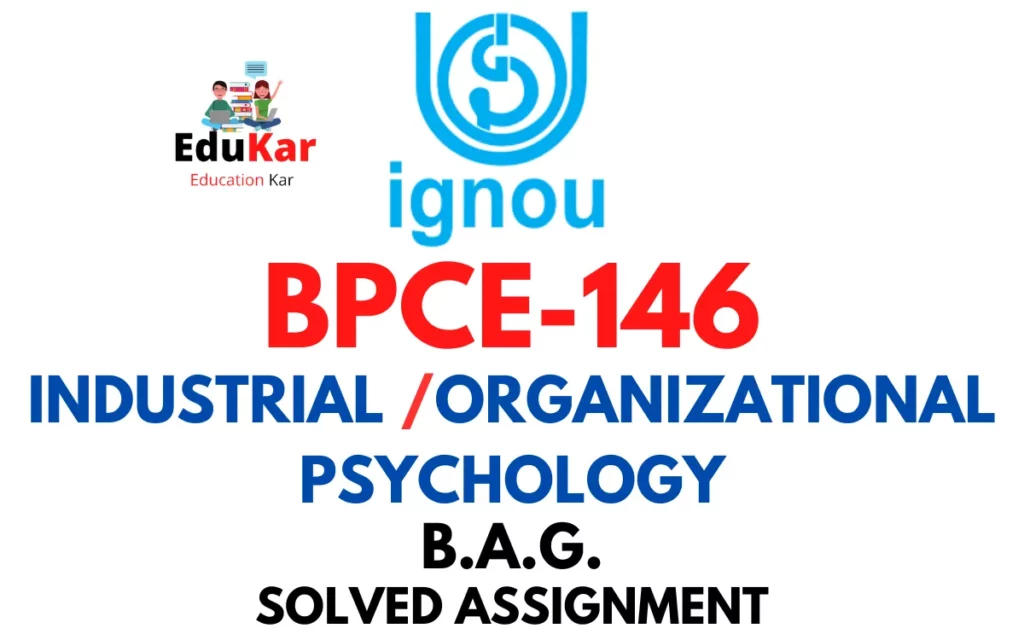



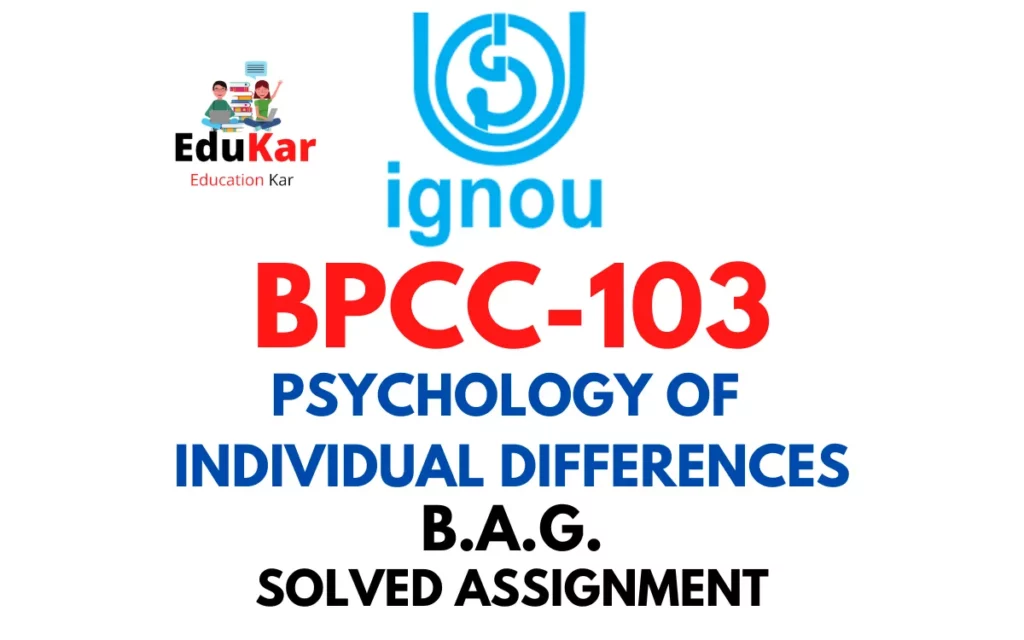

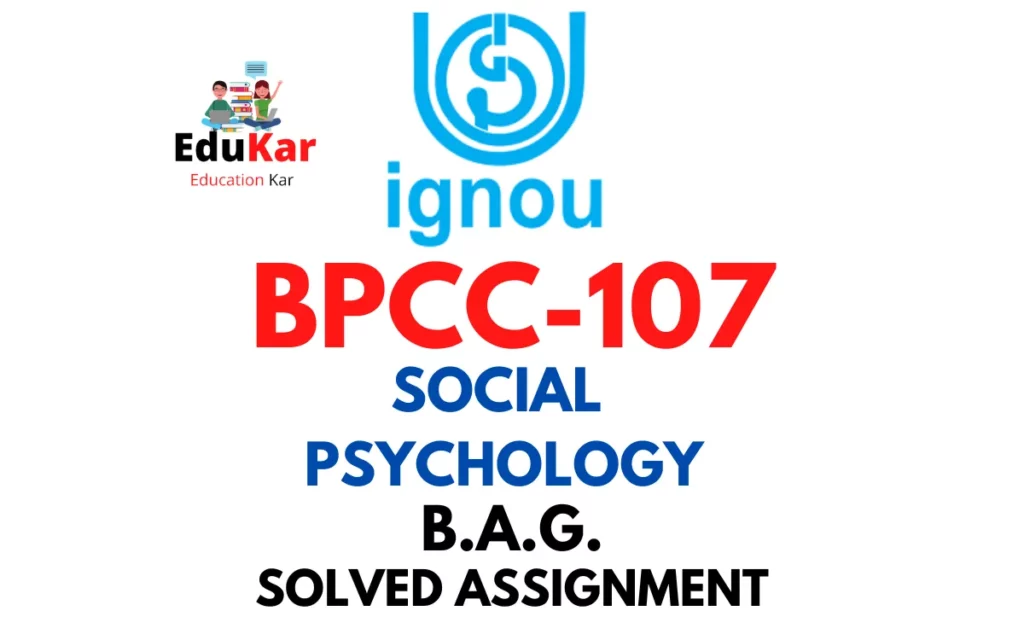

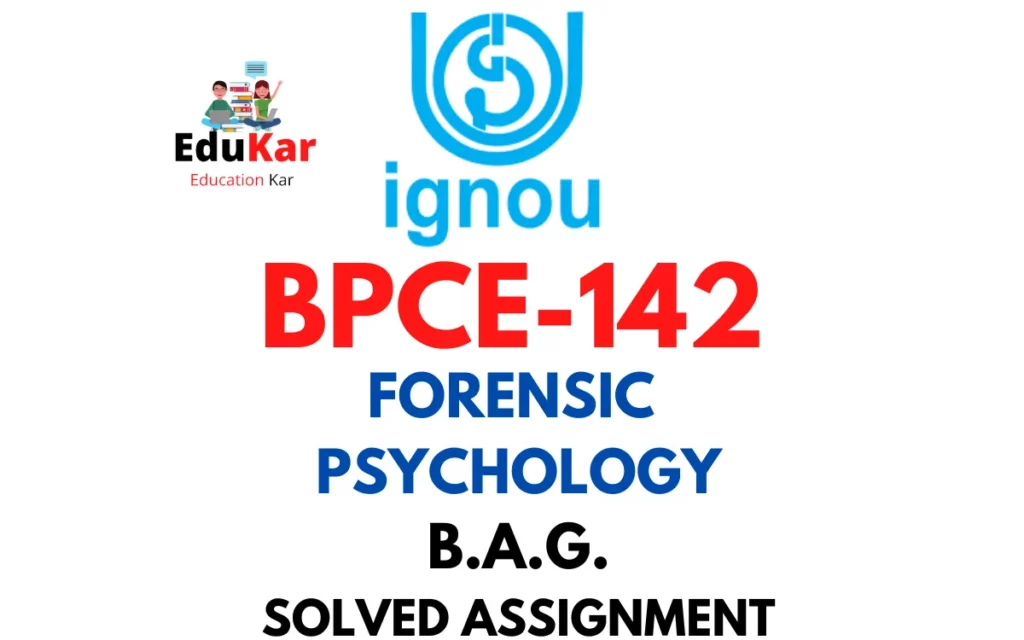
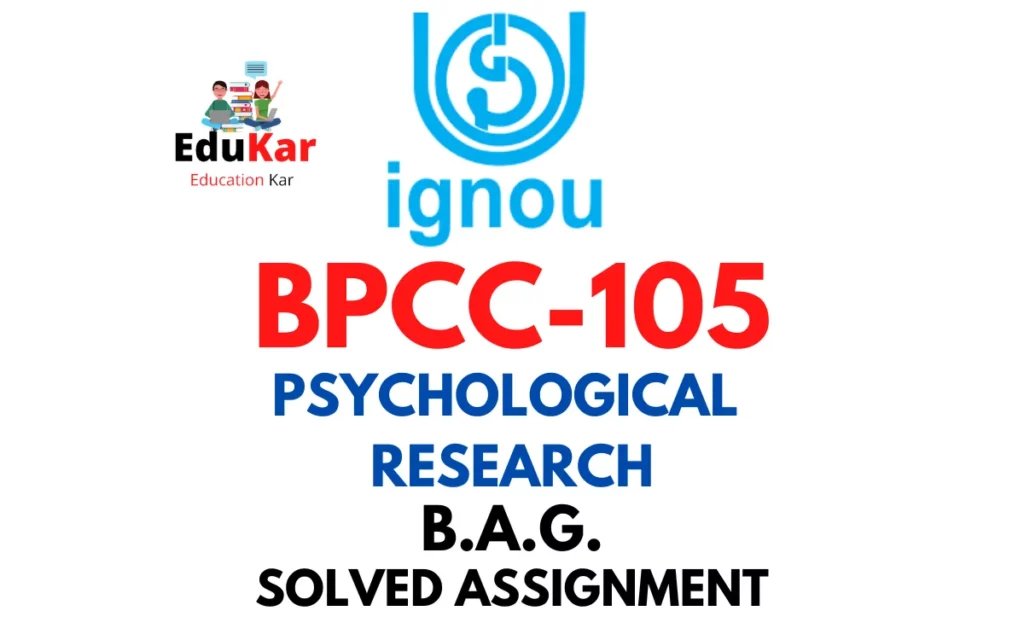
![[Solved Assignment] BPCS 185-DEVELOPING EMOTIONAL COMPETENCE (IGNOU-BAG) 2022-2023 [Solved Assignment] BPCS 185-DEVELOPING EMOTIONAL COMPETENCE (IGNOU-BAG) 2022-2023](https://edukar.in/wp-content/plugins/contextual-related-posts/default.png)

